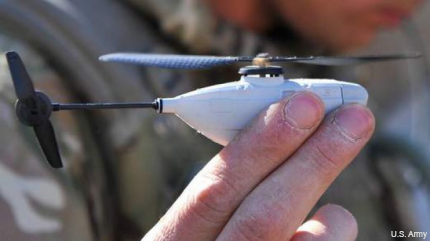An ISR drone in your pocket
Natick researchers are adapting a 16-gram, remotely operated helicopter that could send real-time video to soldiers and squads, indoors or out.

Natick researchers are starting with the commercial PD-100 Black Hornet.
A soldier who needs a quick assessment of a confined area, or who needs to know what’s in the next room inside a building, may soon be able reach into a pocket for a Matchbox-sized drone that can do the job.
Researchers at the Army’s Natick Soldier Research, Development and Engineering Center in Massachusetts are developing such a device specifically for soldiers in small, squad-sized units under a program called Cargo Pocket Intelligence, Surveillance and Reconnaissance, or CP-ISR. It could give squads the type of ISR currently provided only for larger units and even work where traditional, larger systems can’t, such as areas with think tree cover, inside buildings or around villages, the Army said in a release.
Natick engineers are starting with a commercial device, Prox Dynamics' PD-100 Black Hornet—which it refers to as CP-ISR’s “surrogate system”—and looking to adapt its technology for military use.
The PD-100, which the Norway-based Prox says is the first commercially available airborne “personal reconnaissance system,” is a 16-gram helicopter that can fit in the palm of your hand. It can fly for 20 minutes, be guided remotely by GPS navigation, and send real-time video from its three cameras back to a handheld controller. Its small electric motors and propellers make it virtually inaudible, the Army said.
The company touts the PD-100 as useful for surveillance outdoors and in confined areas, and says it also could be used for tasks ranging from search and rescue to inspecting a chemical plant after an accident.
That’s a start, but to get the technology ready for the battlefield, Army researchers are looking to make improvements in three areas.
1. Redesigning its data link so that it works with the Army’s tactical network.
2. Adapting its cameras so that they can work in low light, both indoors and out.
3. Enhance its guidance, navigation and control capabilities to improve how it works in confined spaces, such as when moving room-to-room through a building.
The end result could be some version of the PD-100 or something else, but the goal is to provide small units with portable ISR that doesn’t add much to the weight they have to carry. Natick researchers said they plan to collaborate in November with other Army organizations, including the Maneuver Center of Excellence and the Army Research Laboratory, to demonstrate mobile sensor capabilities.
"The Cargo Pocket ISR is a true example of an applied systems approach for developing new soldier capabilities," Dr. Laurel Allender, acting technical director at the Natick research center, said in the Army’s release. "It provides an integrated capability for the soldier and small unit for increased situational awareness and understanding with negligible impact on Soldier load and agility."



